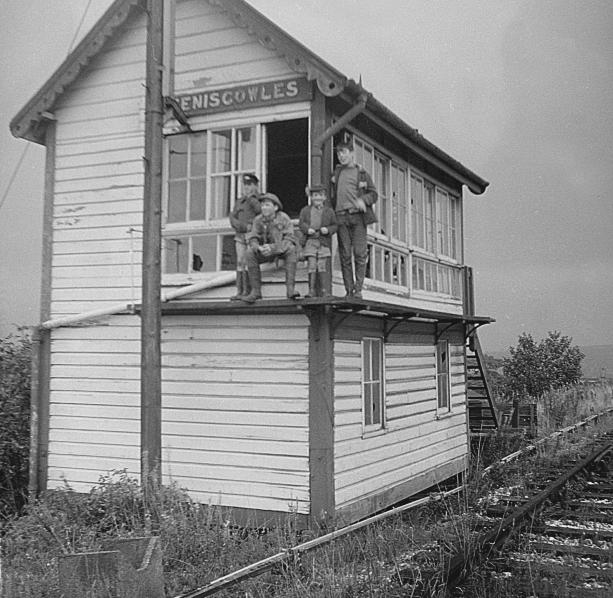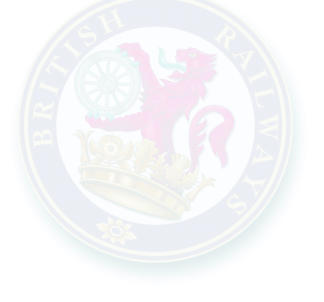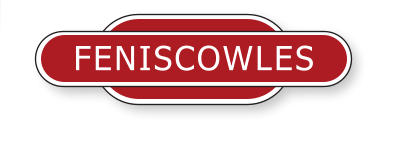


© www.white-coppice.co.uk 2022
There were four children – John, Stephen,
Paul and Mark, born between 1953 and 1962, sons of Alec
and Margaret and we lived at Feniscowles railway station,
in the station-master’s house. How this came to be was
because our Dad was a railway worker.
He had started as
a cleaner at Lower Darwen engine sheds and became a
fireman on the footplate of steam engines. He then applied
to work as a signalman and got a job working in the
Feniscowles signal box. Our parents took the opportunity
of living in the station house (owned by British Railways)
near to the signal box as part and parcel of our Dad’s job.
Feniscowles station was situated on the Blackburn –
Chorley line, opening in 1869, which branched off from the
main line to Preston at Cherry Tree. On Preston Old Road
today, you can still see the three arched viaduct that use to
carry the line up the hill, over the canal and to the station.
The station had lost its passenger service in the early
1960s but was still open to freight trains, Sunday
diversions and holiday specials. Some of the freight trains
would be coming from Carlisle and heading for
Bolton/Wigan and the West Coast main line (and vice-
versa), so going via Feniscowles was a more direct route
than going via Preston. In the early years of living there,
my brothers can remember such trains passing through.
One of them was called ‘The Long Meg’. This was a
regular freight service from the Long Meg Plaster and
Mineral Company mine at Little Salkeld (in the Eden valley)
to Widnes, consisting of quite a large number of identical
freight wagons containing anhydrite. These trains were
headed by one of British Rail’s most powerful locomotives
of the time – usually a Standard 9F 2-10-0. The station
was situated at the head of a 1 in 60 gradient, so these
engines really worked hard to get the train up the hill and
on to Withnell, Brinscall and beyond (which was still all
uphill). The whole house seemed to shake when these
trains thundered past.
The station house was divided into two parts, living
quarters and railway rooms. Our living space consisted of
a small kitchen, a living room and upstairs, three
bedrooms. The toilet was outside (next to the coal hole).
There was no bathroom. At ground level, next to the living
room, were the railway rooms, which could
only be accessed from the platform and were not used for
‘living’ in. First there was the Waiting Room with a stone
floor and ‘in-built’ wooden seating, followed by
The Real
RAILWAY
CHILDREN
of

the Ticket Office, complete with ticket date stamper
and window into the Waiting Room. The next room was
the Ladies Waiting Room complete with ladies toilet.
Then there was the Lamp Room where paraffin had
been stored to supply all signal lamps with fuel. You
could still smell the strong aroma of paraffin that had
been stored there. Finally there was the Gents Toilets
which was half open to the elements and this had an
aroma of Carbolic Soap. The Ticket Office still had
remnants of British Railways paperwork in the many
drawers, consisting of pads of printed
stationery (not quite A5 size) and smaller assorted
printed pads. During our childhood we mainly played
outside and generally only came indoors if it was too
wet. So the railway rooms naturally became our
territory. The Ticket Office became our headquarters.
Headquarters for what? you might ask. Well, we
formed the pretend ‘RP Club’ which stood for Railway
Police Club, and we would go out ‘on patrol’. All those
printed pads came in handy too, using them for all
sorts of pretend play exercises.
The article below appeared in a local magazine some years ago. Many of the photographs have never been on the internet and all are copyrighted. It’s
a true story of life for four brothers who lived on the railway at the end of steam, and closure of the railway.
This article appears courtesy of Blackburn & Darwen Life magazine to whom I am indebted (and to whom all photos are copyrighted unless otherwise
stated)
Please read in conjunction with Feniscowles Station
Page 1 of 7




The Signal Box situated at the
southern end of the Goods Yard
Page 1 of 7




HAVEy
ou read the story The Railway
Children by E. Nesbit? You have
probably seen the film, about the
exploits of three children (two girls
and a boy) living near a railway line.
Well, what follows next is not fiction.
It really happened.





























